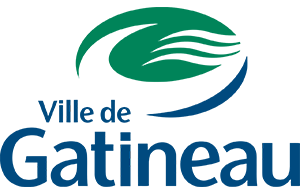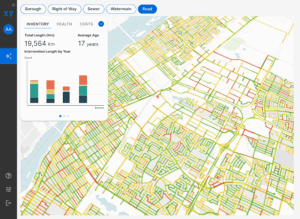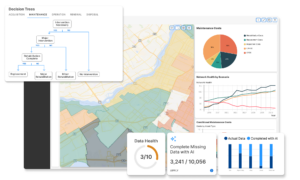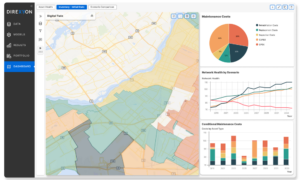How Municipal Asset Management Plans create value
With aging infrastructure, climate change, population growth, and a housing crisis all converging, municipalities are under tremendous pressure to make smart infrastructure decisions. As such, Municipal Asset Management Plans are a valuable framework to guide the decision-making process.
What are Municipal Asset Management Plans?
Municipal Asset Management Plans are long-term, integrated asset management strategies. When taking a holistic view of their, municipalities can better predict asset performance and maximize returns on investment.
Because these plans require regular assessments to determine asset condition, identify risks, and prioritize investments, creating and iterating municipal asset management plans can be challenging.
Fortunately, solutions exist to help municipalities create asset management plans.
Optimizing municipal asset management with Asset Investment Planning
Asset Investment Planning (AIP) is a strategic asset management software.
It combines data and expertise from every aspect of an organization, using simulation and predictive modeling capabilities to create strategic, long-term insights. These insights then serve as the basis of asset management plans.
In short, AIP solutions enable municipalities to consolidate all their data and decision-making into a single platform, projecting its evolution over the next 5, 10, or 25 years.
Additionally, municipalities can also use AIP software to test possible asset management strategies.
For example, they can see how much they save long-term by synchronizing interventions. Or they could test the impact of rehabilitating assets to extend their life versus replacing them outright on their levels of service.
By testing multiple strategies, municipalities ensure they are investing the right amount, on the right asset, at the right time.
What is Asset Investment Planning (AIP)?
The benefits of AIP-powered Asset Management Plans
When municipalities use Direxyon’s AIP to create their asset management plans, they successfully:
Synchronize municipal public works
Instead of conducting maintenance, repairs, and replacements in isolation, municipalities using Direxyon found opportunities to synchronize efforts across departments.
For example, the Roads department have a segment that needs reconstruction.
Meanwhile, the Water department plans to replace a water main underneath that same street within the next four years.
By configuring a simulation to test synchronized interventions, the teams can see that replacing the water main while the road is reconstructed could save a significant amount of money and minimize disruption to citizens.
Decrease break rates
By using AIP’s predictive modeling, municipalities analyze data on past break incidents, current pipe conditions, and environmental factors like soil and weather. The predictive model identifies sections of the water main most at risk of breaking within the next 10 years.
With this information, the city can schedule preventive maintenance for high-risk sections, reducing the likelihood of emergency breaks. And, as a result, avoid the cost damages and emergency repairs.
Create financial predictability
By collecting all current asset condition data – including failure rates and maintenance costs – in an AIP, municipalities predict how many assets will fail in the next 25 years
Configuring risk tolerance and desired service levels, the municipality can see yearly costs for maintaining and replacing assets. They can test scenarios targeting high-risk assets, proactive replacement scenarios, and scenarios with minimal maintenance.
When comparing these scenarios, the municipality can identify the most cost-effective strategy with the least amount of risk and maximum performance.
This ensures they make informed decisions about allocating funds, reducing the likelihood of unexpected costs, and maintaining reliable services over the long term.
Enhance your Municipal Asset Management Plans with Direxyon
Municipal Asset Management Plans are designed to ensure that municipalities optimize every dollar they invest.
But even with the best intentions, our ability to predict the future is extremely limited. Thankfully, solutions like Direxyon’s Asset Investment Planning can greatly enhance a municipality’s visibility and predictive capabilities.
To optimize your existing municipal asset management plans, or create them from scratch, get in touch with us today.
Municipalities we serve
Asset Investment Planning FAQs
Asset Investment Planning (AIP) software enhances the long-term, strategic thinking of asset-intensive organizations to optimize performance and minimize risk. By consolidating asset, financial, and regulatory data in a single solution, alongside organization-specific decision-making policies and predictive models, organizations can simulate possible futures and test investment scenarios to make informed decisions aligned with their strategic goals. Learn more about our AIP software.
Traditional asset management often focuses on day-to-day operations and reactive maintenance, relying on historical data and experience rather than predictive analytics and strategic planning. It typically does not prioritize immediate needs over long-term planning and may not integrate financial considerations or advanced risk management strategies as comprehensively as Asset Investment Planning.
Asset Investment Planning is not a standalone process but rather integrative across an organization. It provides a holistic approach to managing assets, factoring in risk, finance, regulatory requirements, operations, and more. In integrating all these aspects of a single organization, silos are replaced by strategic alignment.
The first step to adopting an AIP is to book a demo with Direxyon.







